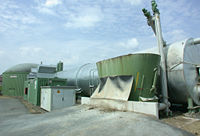
Photo from wikipedia
Manure is an impending source of carbon (C), sulfur (S) and water (H2O). Consequently, microbial populations utilize these constituents to produce methane (CH4), carbon dioxide (CO2), greenhouse gases (GHGs), and… Click to show full abstract
Manure is an impending source of carbon (C), sulfur (S) and water (H2O). Consequently, microbial populations utilize these constituents to produce methane (CH4), carbon dioxide (CO2), greenhouse gases (GHGs), and hydrogen sulfide (H2S). Application of nanoparticles (NPs) to stored manure is an emerging GHG mitigation technique. In this study, two NPs: nano zinc oxide (nZnO) and nano silver (nAg) were tested in swine manure stored under anaerobic conditions to determine their effectiveness in mitigating gaseous emissions and total gas production. The biological sources of gas production, i.e., microbial populations were characterized via Quantitative Polymerase Chain Reaction (qPCR) analysis. Additionally, pH, redox, and VFAs were determined using standard methods. Each treatment of the experiment was replicated three times and NPs were applied at a dose of 3 g/L of manure. Also, headspace gas from all treatment replicates were analyzed for CH4 and CO2 gas concentrations using an SRI-8610 Gas Chromatograph and H2S concentrations were measured using a Jerome 631X meter. Nanoparticles tested in this study reduced the cumulative gas volume by 16%-79% compared to the control. Among the NPs tested, only nZnO consistently reduced GHG concentrations by 37%-97%. Reductions in H2S concentrations ranged from 87% to 97%. Gaseous reductions were likely due to decreases in the activity and numbers of specific gas producing methanogenic archaea and sulfate reducing bacterial (SRB) species.
Journal Title: Journal of environmental sciences
Year Published: 2019
Link to full text (if available)
Share on Social Media: Sign Up to like & get
recommendations!